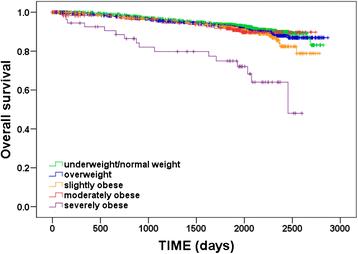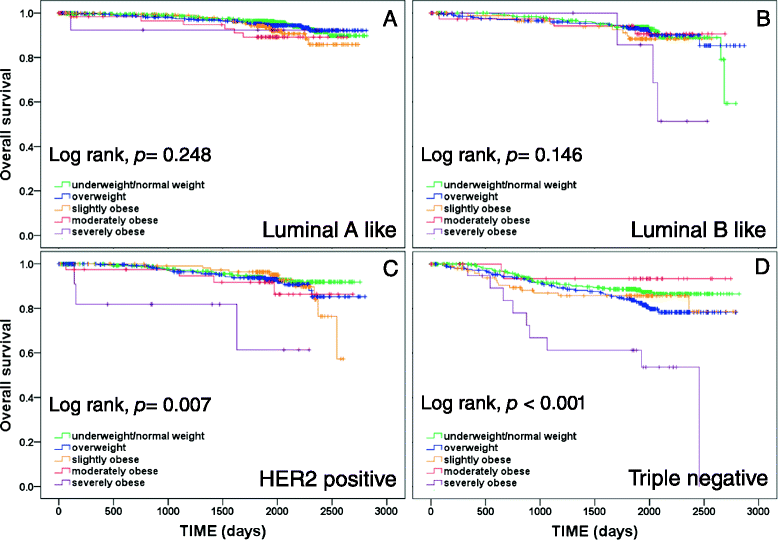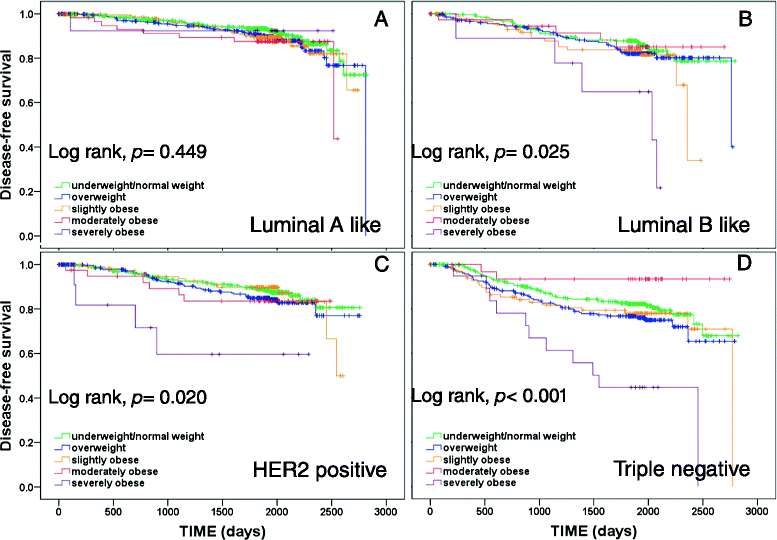The influence of obesity on survival in early, high-risk breast cancer: results from the randomized SUCCESS A trial
- PMID: 26385214
- PMCID: PMC4575482
- DOI: 10.1186/s13058-015-0639-3
The influence of obesity on survival in early, high-risk breast cancer: results from the randomized SUCCESS A trial
Abstract
Introduction: Obese breast cancer patients have worse prognosis than normal weight patients, but the level at which obesity is prognostically unfavorable is unclear.
Methods: This retrospective analysis was performed using data from the SUCCESS A trial, in which 3754 patients with high-risk early breast cancer were randomized to anthracycline- and taxane-based chemotherapy with or without gemcitabine. Patients were classified as underweight/normal weight (body mass index (BMI) < 25.0), overweight (BMI 25.0-29.9), slightly obese (BMI 30.0-34.9), moderately obese (BMI 35.0-39.9) and severely obese (BMI ≥ 40.0), and the effect of BMI on disease-free survival (DFS) and overall survival (OS) was evaluated (median follow-up 65 months). In addition, subgroup analyses were conducted to assess the effect of BMI in luminal A-like, luminal B-like, HER2 (human epidermal growth factor 2)-positive and triple-negative tumors.
Results: Multivariate analyses revealed an independent prognostic effect of BMI on DFS (p = 0.001) and OS (p = 0.005). Compared with underweight/normal weight patients, severely obese patients had worse DFS (hazard ratio (HR) 2.70, 95 % confidence interval (CI) 1.71-4.28, p < 0.001) and OS (HR 2.79, 95 % CI 1.63-4.77, p < 0.001), while moderately obese, slightly obese and overweight patients did not differ from underweight/normal weight patients with regard to DFS or OS. Subgroup analyses showed a similar significant effect of BMI on DFS and OS in patients with triple-negative breast cancer (TNBC), but not in patients with other tumor subtypes.
Conclusions: Severe obesity (BMI ≥ 40) significantly worsens prognosis in early breast cancer patients, particularly for triple-negative tumors.
Trial registration: Clinicaltrials.gov NCT02181101 . Registered September 2005.
Figures




References
-
- De Azambuja E, McCaskill-Stevens W, Francis P, Quinaux E, Crown JPA, Vicente M, et al. The effect of body mass index on overall and disease-free survival in node-positive breast cancer patients treated with docetaxel and doxorubicin-containing adjuvant chemotherapy: the experience of the BIG 02–98 trial. Breast Cancer Res Treat. 2010;119:145–53. doi: 10.1007/s10549-009-0512-0. - DOI - PubMed
Publication types
MeSH terms
Substances
Associated data
LinkOut - more resources
Full Text Sources
Other Literature Sources
Medical
Research Materials
Miscellaneous

